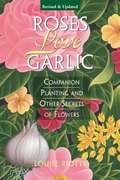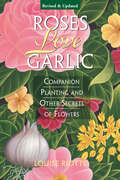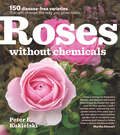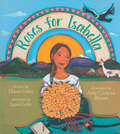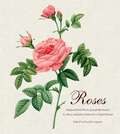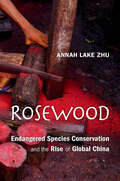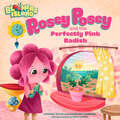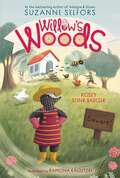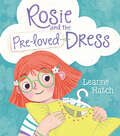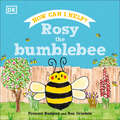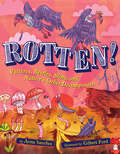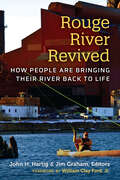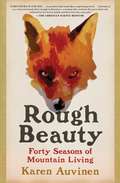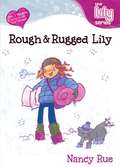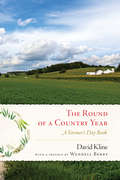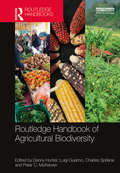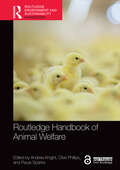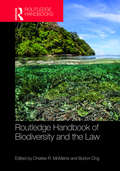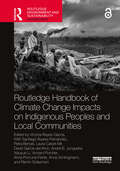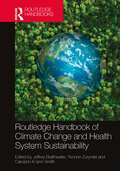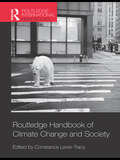- Table View
- List View
Roses Love Garlic: Companion Planting and Other Secrets of Flowers
by Louise RiotteThis sequel to Carrots Love Tomatoes lists hundreds of herbs and flowers, with information on how their proximity can maximize the health and yield of vegetables, berry bushes, and fruit and nut trees.
Roses Love Garlic: Companion Planting and Other Secrets of Flowers
by Louise RiotteFrom deterring insect pests with hot peppers to encouraging strawberries by bordering them with chrysanthemums, Louise Riotte shows you how to use the natural qualities of common plants to increase your garden’s productivity. Roses Love Garlic profiles hundreds of plants, features sample garden designs, and includes recipes for using your harvest to make herbal cosmetics, medicinal mixtures, and plant-based dyes. You’ll enjoy learning about the fascinating ways plants work together as you tend to a thriving and bountiful garden.
Roses Without Chemicals: 150 Disease-Free Varieties That Will Change the Way You Grow Roses
by Peter Kukielski“I wish I had this when I planted my rose garden twenty-five years ago. I am now about to plant another garden, full of wonderful rose varieties and I intend to follow Peter's advice wholeheartedly.” —Martha Stewart Have you tried to grow roses, only to give up once you realized how dependent on pesticides they are? In this lush guide rose expert Peter Kukielski highlights 150 rose varieties that excel in gardens without the use of chemicals. Roses Without Chemicals features information on planting, pruning, and pests; plant profiles that include a color photo and details on color, growth habit, and fragrance; and helpful lists of roses organized by color, growing habit, and region.
Roses for Isabella
by Diana CohnStop and smell the roses of Ecuador with Isabella as she learns how treating farmworkers and Mother Earth fairly makes the world bloom! También disponible en español.Isabella loves to write, especially about the vibrant flowers her parents grow as farmworkers. When her teacher announces a school writing contest in honor of Pachamama, Mother Earth, Isabella decides to write about the rose farms where "pink, red, yellow, and orange roses grow in rows that go on forever." In sweet poems and journal entries, Isabella notes how her parents feel much better working at a new Fair Trade farm. This new farm takes a lot of steps to keep both farmworkers and the environment safe, like avoiding dangerous pesticides that make people, especially farmworkers, sick. With clear, joyful text by acclaimed author Diana Cohn, and captivating illustrations, Roses for Isabella introduces readers to the cultural traditions of Ecuador and the importance of making choices that support farmworkers and the environment. Award-winning illustrator Amy Córdova Boone presents Isabella's world in artwork as vibrant as her beloved flowers. Join Isabella in this celebration of farmworkers and the beautiful gifts we receive from Mother Earth!
Roses: Mini Archive
by Pierre Joseph Redoute James SowerbyThis gorgeous keepsake showcases the skillful artwork of two men who dedicated their lives to botanical illustration, the Belgian Pierre-Joseph Redouté (1759-1840) and his English contemporary, James Sowerby (1757-1822).The beautiful rose plates featured within are original reproductions of drawings which came to life in England’s Kew Gardens, the Gardens of Versailles, and at the Château de Malmaison, the residence of Napoleon’s first wife. Each plate is artfully reproduced from the extraordinarily images found in Redouté’s Les Roses (1817-21) and Sowerby’s English Botany (1780-1814). A comprehensive index at the back of the book uses the artists’ original language to describe the intricacies of the rose colors, their velvety textures, and their intoxicating scents.To bring this lovely book into the 21st century, the paperback format and low price make this rare and significant volume accessible and affordable. A DVD is also included with images of the roses to be used by readers at their discretion.
Rosewood: Endangered Species Conservation and the Rise of Global China
by Annah Lake ZhuA riveting study of the booming rosewood trade between China and Madagascar uncovers an alternative approach to environmentalism that disrupts Western models. Rosewood is the world’s most trafficked endangered species by value, accounting for larger outlays than ivory, rhino horn, and big cats put together. Nearly all rosewood logs are sent to China, fueling a $26 billion market for classically styled furniture. Vast expeditions across Asia and Africa search for the majestic timber, and legions of Chinese ships sail for Madagascar, where rosewood is purchased straight from the forest. The international response has been to interdict the trade, but in this incisive account Annah Lake Zhu suggests that environmentalists have misunderstood both the intent and the effect of China’s appetite for rosewood, causing social and ecological damage in the process. For one thing, Chinese consumers are understandably seeking to reclaim their cultural heritage, restoring a centuries-old tradition of home furnishing that the Cultural Revolution had condemned. In addition, Chinese firms are investing in environmental preservation. Far from simply exploiting the tree, businesses are carefully managing valuable forests and experimenting with extensive new plantings. This sustainable-use paradigm differs dramatically from the conservation norms preferred by Western-dominated NGOs, whose trade bans have prompted speculation and high prices, even encouraging criminal activity. Meanwhile, attempts to arm conservation task forces—militias meant to guard the forests—have backfired. Drawing on years of fieldwork in China and Madagascar, Rosewood upends the pieties of the global aid industry. Zhu offers a rigorous look at what environmentalism and biodiversity protection might look like in a world no longer dominated by the West.
Rosey Posey and the Perfectly Pink Radish: Bloomers Island Garden of Stories #2 (Bloomers Island #2)
by Courtney Carbone Cynthia WylieFollow young Rosey Posey in a magical, beautifully illustrated story as she attends boarding school on Bloomers Island to learn about gardening and growing her own vegetables. When Professor Sage announces the Very Very Veggie Challenge, Rosey isn&’t sure she wants to participate. But encouraged by headmaster Professor Sage and inspired by her favorite color, Rosey decides to grow a perfectly pink radish—in a perfectly pink pot on her perfectly pink windowsill! With patience and curiosity, she discovers just how fun and rewarding gardening can be, and not as hard as she thought!The Bloomers Island series brings to life the world of gardening and healthy-eating to young children in new and exciting ways.
Rosey Stink Badger (Willow’s Woods #2)
by Suzanne SelforsWillow, the great-granddaughter of Mother Nature, recruits the help of a stink badger in this second book in the charmingly whimsical chapter book series from bestselling and award-winning author Suzanne Selfors.When Willow agreed to house-sit for her grandmother, Mother Nature, she had no idea how difficult it would be. The songbirds rudely wake her up at dawn. Mrs. Hedgehog serves worm pancakes for breakfast. And the to-do list is even longer than it was yesterday! To make matters worse, a feisty queen bee has moved into the chicken coop, sending Mother Nature&’s beloved chickens into a tizzy. There&’s only one critter who can catch the bee&’s monarch: the stink badger. But no one ever visits or talks to them because, if disturbed, they&’ll spray a horrid stench from their bottoms. Can Willow be brave enough to care for the natural balance in Mother Nature&’s absence by facing one dangerous foe to get rid of another?
Rosie Sprout's Time to Shine
by Patrice Barton Allison WortcheViolet runs the fastest, sings the highest, looks the fanciest, and talks the loudest. Everyone agrees that she's the best.Except Rosie. Rosie isn't fast, or loud, or fancy, but she's tired of hearing that Violet is the best. When their class grows pea plants, Rosie's and Violet's are the first to sprout! But Violet's is a little taller. So Rosie pushes some soil over Violet's sprout to slow it down. And for a moment, Rosie's plant is the best--but she feels terrible. And she feels even worse when she learns that Violet has the chicken pox.So for the next two weeks, Rosie waters her plant--and Violet's too. She turns them in the sun, and sings them quiet growing songs. And her teacher says that Rosie is the best gardener she's ever had. Definitely the best.This empathetic story captures every child's desire to be noticed and praised, and the subtle competitions that go on in a classroom. It's a book to swell every shy child's heart.From the Hardcover edition.
Rosie and the Pre-Loved Dress
by Leanne HatchA sweet picture book about a girl who finds a special dress at a thrift store and imagines who may have owned the dress before her.When Rosie finds the most beautiful yellow dress at her local thrift store, the first thing she notices when she brings it home is a name written on the tag: Mila. Rosie wonders if Mila liked any of the same things she did, and what amazing things Mila might have done in the dress. The dress makes Rosie feel like her best self--like she can do anything. But soon it&’s time to donate the dress so someone else can make their own memories with it. Letting it go is hard, but Rosie smiles when she wonders what the dress&’s next owner will do while wearing it…. The joy and wonder of recycled clothing is brought to life by Leanne Hatch's charming text and whimsical illustrations.
Rosy the Bumblebee (Roly and Friends #Vol. 2)
by Frances RodgersA delightful picture book that shows young readers how they can help the sweet bumblebees that like to visit gardens, parks, and outdoor spaces.Step outside and find out how you can help the adorable animals that like to visit parks, outdoor spaces, and gardens. Little ones will love following Rosy the Bumblebee as she flies around outside, finding wonderfully colorful flowers to feed on and a cozy corner to rest in after a long, hard day of exploring—and more importantly, collecting pollen! But with bumps along the way, she&’ll need your help. Will you volunteer as her little helper? This sweet picture book gently introduces young readers to the idea of animal conservation and protection. Bursting with fun trivia, little ones are shown just how unique bumblebees are, which makes them worth preserving. But with plenty of tips and tricks for how we can care for garden-dwelling friends like Rosy and keep them safe from the dangers they may face, no one is too young to start making a difference. Rosy the Bumblebee is the perfect gift for any small-animal lover, or budding environmentalist, and will inspire toddlers to discover so much of what is unseen outdoors.
Rotten!: Vultures, Beetles, Slime, and Nature's Other Decomposers
by Anita SanchezA funny and fact-filled look at decomposition in all of its slimy glory, illustrated with dazzling full-color art by Gilbert Ford. Vultures, fungi, dung beetles, and more aid in this fascinating and sometimes smelly aspect of the life cycle that’s right under our noses.What’s that terrible smell? It’s the revolting scent of rot. But being rotten isn’t necessarily bad. If nothing ever rotted, nothing new could live.Decomposition may seem like the last stop on the food chain, but it’s just the beginning. When dead plants and animals decay, they give life to a host of other creatures, and each one helps ecosystems thrive.Decomposition happens in the forest, the ocean—even in your stomach and between your teeth! From vultures and sharks to bacteria, maggots, mushrooms, and more, discover the dirty rotten truth about one of nature’s most fascinating processes.
Rouge River Revived: How People Are Bringing Their River Back to Life
by John H. Hartig Jim GrahamThe Rouge River is a mostly urbanized watershed of about 500 square miles populated by nearly 1.4 million people. While not geographically large, the river has played an outsized role in the history of southeast Michigan, most famously housing Ford Motor Company’s massive Rouge Factory, designed by architect Albert Kahn and later memorialized in Diego Rivera’s renowned “Detroit Industry” murals. In recent decades, the story of the Rouge River has also been one of grassroots environmental activism. After pollution from the Ford complex and neighboring factories literally caused the river to catch on fire in 1969, community groups launched a Herculean effort to restore and protect the watershed. Today the Rouge stands as one of the most successful examples of urban river revival in the country. Rouge River Revived describes the river’s history from pre-European times into the 21st century. Chapters cover topics such as Native American life on the Rouge; indigenous flora and fauna over time; the river’s role in the founding of local cities; its key involvement in Detroit’s urban development and intensive industrialization; and the dramatic clean-up arising from citizen concern and activism. This book is not only a history of the environment of the Rouge River, but also of the complex and evolving relationship between humans and natural spaces.
Rough Beauty: Forty Seasons of Mountain Living
by Karen AuvinenIn the bestselling tradition of Cheryl Strayed&’s Wild and Helen MacDonald&’s H Is for Hawk, Karen Auvinen, an award-winning poet, ventures into the wilderness to seek answers to life&’s big questions with &“candor [and] admirable courage&” (Christian Science Monitor).Determined to live an independent life on her own terms, Karen Auvinen flees to a primitive cabin in the Rockies to live in solitude as a writer and to embrace all the beauty and brutality nature has to offer. When a fire incinerates every word she has ever written and all of her possessions—except for her beloved dog Elvis, her truck, and a few singed artifacts—Karen embarks on a heroic journey to reconcile her desire to be alone with her need for community. In the evocative spirit of works by Annie Dillard, Gretel Ehrlich, and Terry Tempest Williams, Karen&’s &“beautiful, contemplative…breathtaking [debut] memoir honors the wildness of the Rockies&” (Publishers Weekly, starred review). &“Rough Beauty offers a glimpse into a life that&’s pared down to its essentials, open to unexpected, even profound, change&” (Brevity Magazine), and Karen&’s pursuit of solace and salvation through shedding trivial ties and living in close harmony with nature, along with her account of finding community and even love, is sure to resonate with all of us who long for meaning and deeper connection. An &“outstanding…beautiful story of resilience&” (Kirkus Reviews, starred review), Rough Beauty is a luminous, lyric exploration, &“a narrative that reads like a captivating novel...a voice not found often enough in literature—a woman who eschews the prescribed role outlined for her by her family and discovers her own path&” (Christian Science Monitor) to embrace the unpredictability and grace of living intimately with the forces of nature.
Rough and Rugged Lily
by Nancy RueLily's looking for adventure, and the great outdoors is just the place to find it! Convinced she'll become the next famous outdoorswoman, Lily asks her parents for tons of camping and survival gear for Christmas.
Round
by Joyce Sidman Taeeun YooIf you look closely, you will find that the world is bursting, swelling, budding, and ripening with round things awaiting discovery—like eggs about to hatch, sunflowers stretching toward the sun, or planets slowly spinning together for billions of years.Whimsical and imaginative, this poetic ode to all that is round and full of wonder by the Newbery Honor–winning author and poet Joyce Sidman, with illustrations by the two-time New York Best Illustrated Book award recipient Taeeun Yoo, inspires curiosity and wonder for this (round) little earth we call home.
Round of a Country Year: A Farmer's Day Book
by David KlineDavid Kline has been called a "twentieth–century Henry David Thoreau" by his friends and contemporaries; an apt comparison given the quiet exuberance with which he records the quotidian goings–on on his organic family farm. Under David's attentive gaze and in his clear, insightful prose the reader is enveloped in the rhythms of farm life; not only the planting and harvesting of crops throughout the year, but the migration patterns of birds, the health and virility of honeybees left nearly to their own devices, the songs and silences of frogs and toads, the disappearance and resurgence of praying mantises in fields–turned woodlands, the search for monarch butterflies in the milkweed. There's rhythm in community, too—neighbors gathering to plant potatoes or to maintain an elderly friend's tomato garden, organic farming conferences and meetings around family dining tables or university panels.Interspersed with local lore (when the spring's first bumblebee appears the children can go barefoot) is deep technical knowledge of cultivation and land management and the hazards of modern agri–business. Kline records statewide meetings of district supervisors, knows which speakers and committee chairmen are in the pockets of the oil and gas lobbyists, stands up and says his part.At a time when America's population is being turned toward the benefits of small, local farming practices on our health and our environment, Kline's daybook offers a striking example of the ways in which we are connected to our environment, and the pleasure we can take in daily work and stewardship.
Routledge Handbook for Creative Futures (Routledge Environment and Sustainability Handbooks)
by Gabrielle Donnelly Alfonso MontuoriAs the uncertainty of global and local contexts continues to amplify, the Routledge Handbook for Creative Futures responds to the increasing urgency for reimagining futures beyond dystopias and utopias. It features essays that explore the challenges of how to think about compelling futures, what these better futures might be like, and what personal and collective practices are emerging that support the creation of more desirable futures. The handbook aims to find a sweet spot somewhere between despair and naïve optimism, neither shying away from the massive socio-environmental planetary challenges currently facing humanity nor offering simplistic feel-good solutions. Instead, it offers ways forward—whether entirely new perspectives or Indigenous and Traditional Knowledge perspectives that have been marginalized within modernity—and shares potential transformative practices. The volume contains contributions from established and emerging scholars, practitioners, and scholar-practitioners with diverse backgrounds and experiences: a mix of Indigenous, Black, Asian, and White/Caucasian contributors, including women, men, and trans people from around the world, in places such as Kenya, India, US, Canada, and Switzerland, among many others. Chapters explore critical concepts alongside personal and collective practices for creating desirable futures at the individual, community, organizational, and societal levels. This scholarly and accessible book will be a valuable resource for researchers and students of leadership studies, social innovation, community and organizational development, policy studies, futures studies, cultural studies, sociology, and management studies. It will also appeal to educators, practitioners, professionals, and policymakers oriented toward activating creative potential for life-affirming futures for all.
Routledge Handbook of Agricultural Biodiversity (Routledge Environment and Sustainability Handbooks)
by Luigi Guarino Charles Spillane Danny Hunter Peter C. McKeownThe world relies on very few crop and animal species for agriculture and to supply its food needs. In recent decades, there has been increased appreciation of the risk this implies for food security and quality, especially in times of environmental change. As a result, agricultural biodiversity has moved to the top of research and policy agendas. This Handbook presents a comprehensive overview of our current knowledge of agricultural biodiversity in a series of specially commissioned chapters. It draws on multiple disciplines including plant and animal genetics, ecology, crop and animal science, food studies and nutrition, as well as social science subjects which explore the socio-economic, cultural, institutional, legal and policy aspects of agricultural biodiversity. It focuses not only on the core requirements to deliver a sustainable agriculture and food supply, but also highlights the additional ecosystem services provided by a diverse and resilient agricultural landscape and farming practices. The book provides an indispensable reference textbook for a wide range of courses in agriculture, ecology, biodiversity conservation and environmental studies.
Routledge Handbook of Animal Welfare (Routledge Environment and Sustainability Handbooks)
by Andrew Knight, Clive Phillips, and Paula SparksThis handbook presents a much-needed and comprehensive exploration of the rapidly growing fields of animal welfare and law. In recent years there has been increasing attention paid to our complex, multifaceted relationships with other animals, and in particular, the depth and breadth of various societal uses of animals. This has led to a reconsideration of their moral and social status, which has sometimes challenged the interests of those who use animals. In such a contested domain, sound evidence and reasoning become particularly important. Through firm commitment to such principles, this book explores the biological foundations for the moral consideration of animals and for evolving conceptualisations of animal welfare. It reviews in detail the welfare concerns associated with numerous forms of animal use. The inclusion of key recent developments such as climate change, pandemics, and antimicrobial resistance, ensures this text is among the most current in its field. The ethical implications of the various uses of animals by society are considered, and chapters provide important recommendations for reforms of practice, law, or policy. The status of animal law internationally, and in major world regions, is reviewed. Finally, the book considers human behavioural change and strategies for improving stakeholder communication and education. The handbook is essential reading for students and scholars of animal welfare, animal law and animal ethics everywhere, and for policy-makers and other professionals working in the animal welfare sector.
Routledge Handbook of Biodiversity and the Law
by Charles R. McManis Burton OngThis volume provides a reference textbook and comprehensive compilation of multifaceted perspectives on the legal issues arising from the conservation and exploitation of non-human biological resources. Contributors include leading academics, policy-makers and practitioners reviewing a range of socio-legal issues concerning the relationships between humankind and the natural world. The Routledge Handbook of Biodiversity and the Law includes chapters on fundamental and cutting-edge issues, including discussion of major legal instruments such as the Convention on Biological Diversity and the Nagoya Protocol. The book is divided into six distinct parts based around the major objectives which have emerged from legal frameworks concerned with protecting biodiversity. Following introductory chapters, Part II examines issues relating to conservation and sustainable use of biodiversity, with Part III focusing on access and benefit-sharing. Part IV discusses legal issues associated with the protection of traditional knowledge, cultural heritage and indigenous human rights. Parts V and VI focus on a selection of intellectual property issues connected to the commercial exploitation of biological resources, and analyse ethical issues, including viewpoints from economic, ethnobotanical, pharmaceutical and other scientific industry perspectives.
Routledge Handbook of Climate Change Impacts on Indigenous Peoples and Local Communities (Routledge Environment and Sustainability Handbooks)
by Victoria Reyes-GarcíaThis Handbook examines the diverse ways in which climate change impacts Indigenous Peoples and local communities and considers their response to these changes. While there is well-established evidence that the climate of the Earth is changing, the scarcity of instrumental data oftentimes challenges scientists’ ability to detect such impacts in remote and marginalized areas of the world or in areas with scarce data. Bridging this gap, this Handbook draws on field research among Indigenous Peoples and local communities distributed across different climatic zones and relying on different livelihood activities, to analyse their reports of and responses to climate change impacts. It includes contributions from a range of authors from different nationalities, disciplinary backgrounds, and positionalities, thus reflecting the diversity of approaches in the field. The Handbook is organised in two parts: Part I examines the diverse ways in which climate change – alone or in interaction with other drivers of environmental change – affects Indigenous Peoples and local communities; Part II examines how Indigenous Peoples and local communities are locally adapting their responses to these impacts. Overall, this book highlights Indigenous and local knowledge systems as an untapped resource which will be vital in deepening our understanding of the effects of climate change. The Routledge Handbook of Climate Change Impacts on Indigenous Peoples and Local Communities will be an essential reference text for students and scholars of climate change, anthropology, environmental studies, ethnobiology, and Indigenous studies.
Routledge Handbook of Climate Change Impacts on Indigenous Peoples and Local Communities (Routledge Environment and Sustainability Handbooks)
by Victoria Reyes-GarcíaThis Handbook examines the diverse ways in which climate change impacts Indigenous Peoples and local communities and considers their response to these changes.While there is well-established evidence that the climate of the Earth is changing, the scarcity of instrumental data oftentimes challenges scientists’ ability to detect such impacts in remote and marginalized areas of the world or in areas with scarce data. Bridging this gap, this Handbook draws on field research among Indigenous Peoples and local communities distributed across different climatic zones and relying on different livelihood activities, to analyse their reports of and responses to climate change impacts. It includes contributions from a range of authors from different nationalities, disciplinary backgrounds, and positionalities, thus reflecting the diversity of approaches in the field. The Handbook is organised in two parts: Part I examines the diverse ways in which climate change – alone or in interaction with other drivers of environmental change – affects Indigenous Peoples and local communities; Part II examines how Indigenous Peoples and local communities are locally adapting their responses to these impacts. Overall, this book highlights Indigenous and local knowledge systems as an untapped resource which will be vital in deepening our understanding of the effects of climate change.The Routledge Handbook of Climate Change Impacts on Indigenous Peoples and Local Communities will be an essential reference text for students and scholars of climate change, anthropology, environmental studies, ethnobiology, and Indigenous studies.The Open Access version of this book, available at www.taylorfrancis.com, has been made available under a Creative Commons Attribution-Non Commercial-No Derivatives (CC-BY-NC-ND) 4.0 license.
Routledge Handbook of Climate Change and Health System Sustainability
by Jeffrey Braithwaite Yvonne Zurynski Carolynn K-lynn SmithThe Routledge Handbook on Climate Change and Health System Sustainability takes the reader on a journey to understand the interconnectedness of human health, climate change, and healthcare systems.The book begins by exploring how climate change is affecting human health through the increasing frequency of natural disasters, such as bush fires, droughts and heatwaves, and the emergence of new infectious diseases, such as the SARS-CoV2 virus, all of which drive up demand for health services that are already heavily burdened by increasing rates of chronic diseases and ageing populations. Chapters then turn to the contribution of the healthcare system itself to climate change— explaining how current clinical practices, including wasteful care of low value, create an unsustainable carbon footprint and threaten the very viability of healthcare systems. Throughout the volume, descriptions of practical solutions and implemented case studies are used to illustrate the feasibility of taking action in the real world of the healthcare delivery ecosystem.Bringing together a mix of forward-thinking environmental and health researchers, policymakers, leaders, managers, clinicians, patients, and health industry leaders to clarify the current state and future of sustainable healthcare systems, this book will be of interest to researchers and policymakers of climate and health systems.
Routledge Handbook of Climate Change and Society (Routledge International Handbooks)
by Constance Lever-TracyAs the time-scales of natural change accelerate and converge with those of society, Routledge Handbook of Climate Change and Society takes the reader into largely uncharted territory in its exploration of anthropogenic climate change. Current material is used to highlight the global impact of this issue, and the necessity for multidisciplinary and global social science research and teaching to address the problem. The book is multidisciplinary and worldwide in scope, with contributors spanning specialisms including agro-forestry, economics, environmentalism, ethics, human geography, international relations, law, politics, psychology, sociology and theology. Their global knowledge is reflected in the content of the text, which encompasses chapters on American, European and Chinese policies, case studies of responses to disasters and of the new technological and lifestyle alternatives that are being adopted, and the negotiations leading up to the Copenhagen conference alongside a preface assessing its outcomes. Starting with an initial analysis by a leading climatologist, key issues discussed in the text include recent findings of natural scientists, social causation and vulnerability, media and public recognition or scepticism, and the merits and difficulties of actions seeking to mitigate and adapt. This accessible volume utilizes a wealth of case studies, explains technical terms and minimises the use of acronyms associated with the subject, making it an essential text for advanced undergraduates, postgraduate students and researchers in the social sciences.
